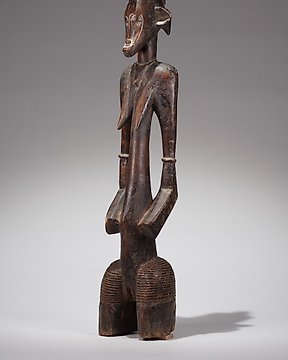
Senufo - 象牙海岸 (沒有保留價)
編號 83432913

編號 83432913

A Senufo Kpelie mask, Ivory Coast, region Korhogo, collected in the Village Karafé, of oval shape with crescent scarifications around the cheeks, two curved horns on each side of the mask, a pointed mouth, thin nose, two slit eyes, crescent eyebrows, protruding forehead, a small male monkey is sitting on the top of the head, touching his stomach, the rims of the mask are punctured with holes to attach a costume; glossy by use, signs of use. Provenance: Belo Mohamed Garba.
“Kpelie-masks were worn during funeral sessions By the Poro society. These funeral festivities are marked by masquerades, which symbolically expresses the fundamental dualities in Senufo Thought: mal/female, body, spitit, life/death. In general this type of mask is symbolizing an ideal woman. The unique features which characterize the Kpelie mask include elongated flanges radiating from the bottom part of the mask, which are a reference to the hornbill bird. The horns on the mask refer to the ram, an important sacrificial animal. The nodules on the forehead represent palm nuts as well as vulvas; they are flanked by cicatrization marks that symbolize the twins born to the primordial couple.”
Holas, B., L'Art Sacré Sénoufo, Limoges, 1978, Facing the Mask, Herreman, Frank, Museum for African Art. s. publ.
“Finely carved face masks were popular in northern Côte d'Ivoire by the early twentieth century. The Belgian art historian Albert Maesen collected a comparable mask when he did fieldwork on Senufo arts in northern Côte d'Ivoire just before the outbreak of World War II. Maesen identified the form as kulié, or "face of the dead." He observed that families owned kulié masks and used them in public dances during agricultural celebrations and funerary ceremonies. Poro associations then also maintained similar face masks to honor deceased members in performances restricted to men. Maesen contrasted the restrained movements of the masqueraders at the events open to all to the more energetic dance of the poro masks in front of select audiences. Sculptors in the region carved face masks throughout the twentieth century. The term kpeliye'e, or "face of the jumping performer," refers to the dynamic performances audiences have continued to associate with the mask. Often centerpieces of entertaining theaters, face masks offer a counterpoint to the region's larger, more combative zoomorphic helmet masks.”